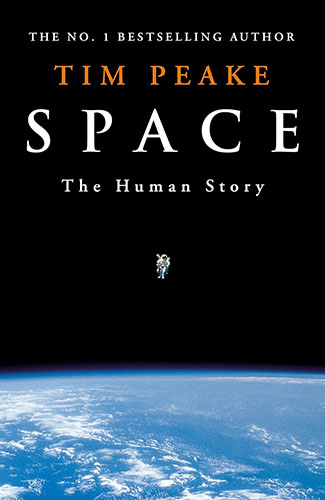Category: Nonfiction
Reviewed by: Douglas G. Adler
Title: Space: The Human Story
Author: Tim Peake
Format: Hardcover/Paperback/Kindle
Pages: 330
Publisher: Century
Date: October 2023
Retail Price: $38.00/$24.00/$17.99
ISBN: 978- 1529913514
Find this book
There are a great many books that detail the history of human spaceflight. Some are geared for newcomers to the topic that provide a broad overview of key events spanning the past 60 years. Other books have more focus and granularity, and are written for those that have a deeper knowledge and understanding of these events and the technical details of lifting human beings from the Earth and putting them in space.
Space: The Human Story by Tim Peake fits more into the former category. The book provides a breezy overview of human spaceflight, covering U.S. and Soviet/Russian endeavors. The title refers to the fact that the book emphasizes personal stories and vignettes and is less focused on international geopolitics and the Cold War that drove much of the Space Race. Significant attention is paid to the American Mercury, Gemini, and Apollo programs as well as the Soviet Vostok and Soyuz programs, working through the Shuttle era, the International Space Station (ISS), and the (potential) upcoming manned Artemis flights. The detail provided regarding the early Soviet space program is a welcome addition, as many space histories gloss over these events in their hurry to tell the story of more accessible U.S. efforts.
The author is himself a former European Space Agency (ESA) astronaut who spent 186 days in orbit aboard the ISS during Expedition 46/47. As such, he is able to bring a different feel to the text than most writers of space histories. He is able to personally describe the rigors of astronaut training, the anxiety one feels before launch, what it actually is like to live and work aboard the ISS for an extended period of time, and how it felt to actually leave the ISS and perform a spacewalk. These reflections give the book a personal touch and a level of immediacy that is engaging and endearing and are some of the most interesting sections of the book.
Critically, there is an extreme paucity of discussion of private manned spaceflight from the likes of SpaceX, Blue Origin, and Virgin Galactic. This omission is glaring, and to the book’s detriment. Readers would have likely been interested in Peake’s take on what it means to have spaceflight carried out by private companies, often from private launch sites, delivering humans to space (and, in the case of SpaceX, all the way to orbit and to the ISS itself). Peake briefly mentions that some astronauts are dismissive of such efforts, but much more could have been said on this vital topic given the incredible progress that has been made in this area over the past decade, especially by Elon Musk (who is not even mentioned once) and SpaceX.
Overall, this particular book is probably best suited to newcomers to space history or young readers looking for a single volume that will give them a sense of the broad sweep of human spaceflight in a relatively short time. Space: The Human Story covers much well-worn ground, and many/most of the stories and events that Peake details have been extensively covered in other books and media, including both television and film. Readers of such works as Tom Wolfe’s The Right Stuff, Jim Lovell’s Lost Moon and Andy Chaikin’s A Man on the Moon and viewers of the filmed versions of The Right Stuff, Apollo 13, and HBO’s From the Earth to the Moon miniseries will find little new material here. Given how many spaceflights there have been, it would have been good to hear more new tales that had not yet seen the light of day.
© 2024 Douglas G. Adler



















